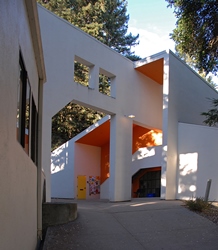American Architects and Modernities, 1945-1980
Overview
While after the second world war the mainstream of American architecture – a “less is more” culture of functionalist glass and steel towers – swept over the world as a visible sign of America’s economic power and political hegemony, a new generation of US architects created provocative alternatives to rationalistic, architectural models and repetitive convention. From the early Philip Johnson to Robert Venturi and Charles Moore, this course follows the highly branched evolution of an American vanguard that deconstructed the paradigms of their teachers by questioning their universal validity. Once again, architecture became a bearer of meaning, thus regaining its close alliance to the visual arts. Today, we may understand this alliance as being crucial to a (re)vitalised urban environment. This, in turn, may underline the substantial impact this period of architecture ha(d)s on current architectural discourse.

Module information
- Module title
American Architects and Modernities, 1945-1980- Module number
HOA00070M- Convenor
Norbert Nussbaum
For postgraduates
